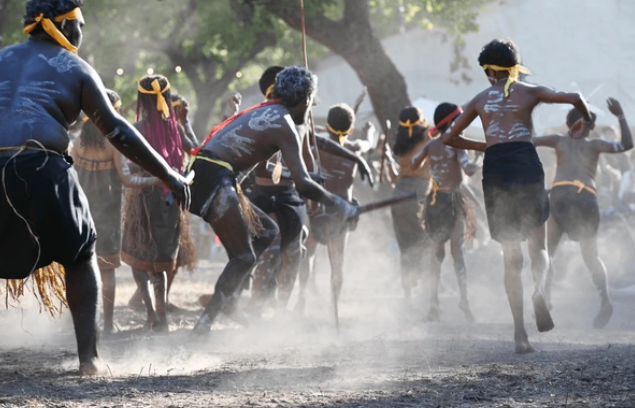Introduction: The Arrival of the First Indigenous Australians
The arrival of the first Indigenous Australians marks one of the most significant and enduring stories in human history. Tracing back over 60,000 years, this rich tapestry of cultural heritage, adaptation, and survival provides a profound insight into the resilience and ingenuity of the world’s oldest continuous civilization. The journey of the Indigenous Australians, their adaptation to diverse environments, and their cultural achievements are a testament to their enduring connection to the land and their sophisticated societal structures.
Understanding the origins, migration patterns, and development of the Indigenous Australian cultures requires a comprehensive exploration of archaeological evidence, oral histories, and modern scientific research. This article delves into the fascinating history of the first Australians, their interaction with the environment, and the profound legacy they have left on the continent.
The Origins and Migration: Theories and Evidence
The origins and migration of the first Indigenous Australians have been the subject of extensive research and debate. Multiple theories and a wealth of archaeological evidence have contributed to our understanding of how these early humans arrived on the Australian continent.
Theories of Migration
There are several prevailing theories regarding the migration of the first Indigenous Australians. One of the most widely accepted theories is that they arrived via a series of coastal and island-hopping migrations from Southeast Asia. This theory is supported by genetic studies and the discovery of ancient human remains in regions that would have served as stepping stones for early migrants.
The alternative theory suggests that a single, rapid migration brought the first humans to Australia, possibly driven by changes in climate and sea levels. This theory is also supported by genetic evidence and the rapid spread of human populations across the continent.
Both theories highlight the incredible adaptability and navigational skills of these early humans, who would have had to traverse significant distances across open water to reach Australia. The exact route and timing of these migrations remain subjects of ongoing research and discovery.
Read Also : The Settlement of Port Phillip (1803): A Crucial Moment in Australian History
Archaeological Evidence: Key Discoveries
Archaeological evidence plays a crucial role in tracing the arrival and settlement of the first Indigenous Australians. Some of the key discoveries include:
- Lake Mungo Remains: The discovery of ancient human remains at Lake Mungo in New South Wales provided some of the earliest direct evidence of human occupation in Australia. The remains, dated to approximately 42,000 years ago, offer insights into the burial practices and lifestyles of early Indigenous Australians.
- Nauwalabila I and Malakunanja II: These rock shelter sites in Northern Australia contain evidence of human habitation dating back to around 50,000 years ago. The artifacts and tools found at these sites indicate sophisticated tool-making techniques and a deep understanding of the local environment.
- Devil’s Lair: Located in Western Australia, Devil’s Lair is another significant archaeological site that has yielded evidence of human occupation dating back over 45,000 years. The site contains a wealth of artifacts, including stone tools, animal bones, and personal ornaments.
These archaeological discoveries, along with many others, provide a detailed picture of the early settlement and adaptation of Indigenous Australians. They reveal a complex and dynamic interaction with the environment, as well as the development of unique cultural practices.
Genetic Studies: Tracing Ancestry
Genetic studies have significantly enhanced our understanding of the migration and ancestry of Indigenous Australians. Analysis of mitochondrial DNA and other genetic markers has revealed deep ancestral connections to populations in Southeast Asia and a long period of isolation following the initial migration.
These genetic studies have also highlighted the remarkable genetic diversity among Indigenous Australian populations, reflecting their adaptation to a wide range of environments across the continent. The genetic evidence supports the theory of a single, early migration followed by a long period of stability and adaptation in Australia.
The combination of archaeological evidence and genetic studies provides a comprehensive understanding of the arrival and settlement of the first Indigenous Australians. These early humans demonstrated remarkable adaptability and resilience, establishing thriving communities across the continent.
Adaptation and Survival: Thriving in Diverse Environments
The ability of Indigenous Australians to adapt and thrive in diverse environments is one of the most remarkable aspects of their history. From the arid deserts of the interior to the lush rainforests of the north, Indigenous Australians developed sophisticated strategies for survival and resource management.
Desert Adaptation: Life in the Arid Interior
One of the most challenging environments in Australia is the arid interior, where temperatures can be extreme and water sources scarce. Indigenous Australians developed a deep understanding of this harsh landscape, utilizing a range of strategies to secure food, water, and shelter.
- Water Management: Indigenous Australians developed ingenious methods for locating and conserving water. This included the use of natural waterholes, the creation of wells and soaks, and the knowledge of water-storing plants.
- Hunting and Gathering: The diet of Indigenous Australians in the desert regions was diverse and relied on a deep knowledge of local flora and fauna. They hunted animals such as kangaroos and emus, and gathered plant foods including seeds, fruits, and tubers.
- Fire Management: The use of fire as a tool for managing the landscape was a key adaptation. Controlled burning, or fire-stick farming, was used to promote the growth of certain plants, manage hunting grounds, and reduce the risk of larger, uncontrolled wildfires.
These strategies enabled Indigenous Australians to sustain their communities in some of the most inhospitable environments on the planet. Their deep ecological knowledge and resource management practices were passed down through generations, ensuring their survival and prosperity.
Coastal and Riverine Adaptation: Utilizing Aquatic Resources
The coastal and riverine environments of Australia provided abundant resources for Indigenous Australians, who developed specialized techniques for fishing, hunting, and gathering in these areas.
- Fishing Techniques: Indigenous Australians developed a variety of fishing methods, including the use of fish traps, nets, and spears. These techniques were adapted to the specific conditions of different coastal and riverine environments.
- Shellfish Gathering: The gathering of shellfish and other marine resources was an important part of the diet for coastal Indigenous communities. Shell middens, large accumulations of shellfish remains, are evidence of long-term, sustainable harvesting practices.
- Aquatic Hunting: In addition to fishing, Indigenous Australians hunted aquatic animals such as turtles and dugongs. These activities required specialized knowledge and skills, reflecting the deep connection between Indigenous Australians and their aquatic environments.
The adaptation to coastal and riverine environments highlights the versatility and ingenuity of Indigenous Australian societies. Their ability to exploit a wide range of resources ensured the sustainability and resilience of their communities.
Rainforest Adaptation: Thriving in Dense Vegetation
The rainforests of northern Australia presented a different set of challenges and opportunities for Indigenous Australians. The dense vegetation and abundant resources required specialized knowledge and skills for successful habitation.
- Plant Utilization: Indigenous Australians in rainforest regions utilized a wide variety of plant resources for food, medicine, and tools. The knowledge of which plants were edible, how to process them, and their seasonal availability was crucial for survival.
- Hunting Practices: The dense vegetation of the rainforest required different hunting techniques. Indigenous Australians developed skills in tracking and hunting animals such as cassowaries, wallabies, and birds.
- Shelter Construction: The construction of shelters in rainforest environments required materials and techniques suited to the humid conditions. Indigenous Australians built sturdy and weather-resistant shelters using locally available materials.
The adaptation to rainforest environments demonstrates the flexibility and innovation of Indigenous Australian societies. Their deep understanding of the local ecology allowed them to thrive in these complex and resource-rich landscapes.
Cultural Achievements: Art, Language, and Social Structure
The cultural achievements of Indigenous Australians are a testament to their sophisticated societal structures and rich heritage. Art, language, and social organization played a crucial role in the cohesion and identity of Indigenous communities.
Indigenous Australian Art: Expression and Identity
Indigenous Australian art is one of the oldest and most diverse artistic traditions in the world. It encompasses a wide range of forms, including rock art, body painting, and contemporary visual arts.
- Rock Art: Rock art sites across Australia contain paintings and engravings that date back thousands of years. These artworks depict animals, human figures, and spiritual beings, reflecting the deep connection between Indigenous Australians and their environment.
- Body Painting: Body painting is an important cultural practice for many Indigenous Australian communities. It is used in ceremonies, rituals, and storytelling, and is often accompanied by dance and music.
- Contemporary Art: Indigenous Australian artists continue to contribute to the global art scene with contemporary works that blend traditional techniques and themes with modern expressions. These artworks are celebrated for their beauty, complexity, and cultural significance.
Indigenous Australian art is not only a form of aesthetic expression but also a means of preserving and transmitting cultural knowledge and identity. The diversity and depth of Indigenous Australian art highlight the creativity and resilience of these communities.
Language Diversity: A Wealth of Linguistic Heritage
Indigenous Australia is home to a remarkable diversity of languages, with over 250 distinct languages spoken at the time of European contact. This linguistic diversity reflects the rich cultural heritage and social organization of Indigenous Australian societies.
- Language Groups: The distribution of Indigenous Australian languages is closely tied to the geographical and social landscapes. Each language group has its own distinct dialects, vocabulary, and grammatical structures.
- Oral Traditions: Indigenous Australian languages are primarily oral, with rich traditions of storytelling, songs, and oral histories. These oral traditions play a crucial role in preserving cultural knowledge and passing it down through generations.
- Language Revitalization: Efforts are being made to revitalize and preserve Indigenous Australian languages, many of which are endangered. Community initiatives, educational programs, and technology are being used to support language learning and transmission.
The arrival of the first Indigenous Australians – The linguistic diversity of Indigenous Australia is a testament to the complexity and richness of these societies. The preservation and revitalization of Indigenous languages are essential for maintaining cultural heritage and identity.
Social Structure and Governance: Community and Kinship
Indigenous Australian societies are characterized by complex social structures and systems of governance based on kinship and community.
- Kinship Systems: Kinship is a fundamental aspect of Indigenous Australian social organization. It defines relationships, responsibilities, and social roles within the community. Kinship systems are diverse and vary between different language groups and regions.
- Community Governance: Indigenous Australian communities have their own systems of governance and decision-making. Elders and respected community members play a central role in maintaining social order and resolving conflicts.
- Ceremonial Practices: Ceremonies and rituals are an integral part of Indigenous Australian social life. They mark important life events, seasonal changes, and spiritual connections. Ceremonies reinforce social bonds and cultural continuity.
The social structure and governance of Indigenous Australian societies highlight the importance of community, cooperation, and respect for cultural traditions. These systems have sustained Indigenous communities for thousands of years and continue to play a vital role in their resilience and cohesion.
Interaction with the Environment: Sustainable Practices and Knowledge
The deep connection between Indigenous Australians and their environment is reflected in their sustainable practices and ecological knowledge. Indigenous Australians have developed sophisticated techniques for managing and caring for the land and its resources.
Traditional Ecological Knowledge: Wisdom and Practice
Traditional ecological knowledge (TEK) encompasses the understanding and practices that Indigenous Australians have developed over thousands of years to manage their environment.
- Fire Management: Fire has been used as a tool for managing the landscape, promoting the growth of certain plants, and creating habitats for animals. Controlled burning, or fire-stick farming, is a key aspect of traditional land management.
- Resource Harvesting: Sustainable harvesting practices ensure that resources are used responsibly and replenished. This includes the rotational use of hunting and gathering areas, seasonal harvesting, and the protection of important species.
- Water Management: Indigenous Australians have developed techniques for finding and conserving water in diverse environments. This includes the use of natural waterholes, the creation of wells, and the management of water-storing plants.
The traditional ecological knowledge of Indigenous Australians is a valuable resource for contemporary environmental management. It offers insights into sustainable practices and the importance of maintaining a balanced relationship with the environment.
Conservation and Biodiversity: Guardians of the Land
Indigenous Australians have long been stewards of the land, with a deep commitment to conservation and biodiversity.
- Cultural Landscapes: The landscapes managed by Indigenous Australians are not just natural environments but also cultural landscapes. They are shaped by traditional practices and hold significant cultural and spiritual meaning.
- Biodiversity Management: Indigenous Australians have developed strategies for maintaining biodiversity, including the protection of endangered species and the sustainable use of resources. Their knowledge of local ecosystems is crucial for conserving biodiversity.
- Collaborative Conservation: Collaborative conservation efforts between Indigenous Australians and environmental organizations are increasingly recognized as essential for effective environmental management. These partnerships leverage traditional knowledge and contemporary science to address conservation challenges.
The role of Indigenous Australians as guardians of the land highlights the importance of their knowledge and practices in preserving the environment. Their commitment to conservation and biodiversity is a testament to their deep connection to the land.
Climate Adaptation: Resilience and Innovation
The ability of Indigenous Australians to adapt to changing climates is a key aspect of their resilience.
- Climate Knowledge: Indigenous Australians have a deep understanding of climatic patterns and variability. This knowledge is based on long-term observations and is passed down through generations.
- Adaptation Strategies: Indigenous Australians have developed strategies for adapting to changing climatic conditions, including the management of water resources, the use of fire, and the diversification of food sources.
- Resilience and Innovation: The resilience of Indigenous Australians is reflected in their ability to innovate and adapt to new challenges. This includes the integration of traditional knowledge with contemporary practices to address climate change.
The adaptation strategies of Indigenous Australians offer valuable lessons for contemporary climate adaptation. Their resilience and innovation highlight the importance of understanding and respecting traditional knowledge in addressing environmental challenges.
The Impact of Colonization: Challenges and Resilience
The arrival of European settlers in the late 18th century had a profound impact on Indigenous Australians, leading to significant challenges and profound changes to their way of life.
Displacement and Disruption
The colonization of Australia by European settlers resulted in the displacement and disruption of Indigenous Australian communities.
- Land Dispossession: The arrival of European settlers led to the widespread dispossession of Indigenous lands. This resulted in the loss of traditional territories and resources, disrupting the social and economic structures of Indigenous communities.
- Cultural Disruption: The imposition of European cultural practices and policies disrupted Indigenous cultural traditions and practices. This included the suppression of languages, ceremonies, and social structures.
- Population Decline: The introduction of new diseases, violence, and displacement led to a significant decline in the Indigenous Australian population. The impact of these factors on Indigenous communities was devastating.
The displacement and disruption caused by colonization had a profound impact on Indigenous Australians, leading to significant challenges and hardships. However, Indigenous Australians demonstrated remarkable resilience in the face of these challenges.
Resistance and Adaptation
Indigenous Australians have a long history of resistance and adaptation in response to the challenges posed by colonization.
- Resistance Movements: Indigenous Australians resisted colonization through various means, including armed resistance, legal challenges, and political activism. These resistance movements aimed to protect Indigenous lands, rights, and cultures.
- Cultural Adaptation: Indigenous Australians adapted to the changing circumstances by finding ways to preserve and adapt their cultural practices. This included the integration of traditional knowledge with new technologies and practices.
- Community Resilience: The resilience of Indigenous communities is reflected in their ability to maintain social cohesion and cultural identity in the face of adversity. Community support networks and the role of Elders have been crucial in sustaining resilience.
The resistance and adaptation of Indigenous Australians highlight their strength and determination in the face of colonization. Their ability to preserve their cultural heritage and adapt to new challenges is a testament to their resilience.
Contemporary Challenges and Achievements
Indigenous Australians continue to face significant challenges but also achieve remarkable successes in various fields.
- Social and Economic Challenges: Indigenous Australians face ongoing challenges related to social and economic disparities, including access to education, healthcare, and employment opportunities.
- Cultural Revitalization: Efforts to revitalize and preserve Indigenous cultures are ongoing. This includes language revitalization programs, cultural heritage projects, and the promotion of Indigenous arts and traditions.
- Political and Legal Achievements: Indigenous Australians have made significant achievements in the political and legal arenas, including the recognition of land rights, the establishment of Indigenous-led organizations, and participation in national and international forums.
The contemporary challenges and achievements of Indigenous Australians highlight the importance of addressing social and economic disparities while celebrating and preserving their cultural heritage. Their contributions to Australian society are significant and diverse.
Conclusion: Reflecting on 60,000 Years of Indigenous Australian History
The arrival of the first Indigenous Australians marks a profound chapter in human history, characterized by resilience, innovation, and a deep connection to the land. Tracing back over 60,000 years, the history of Indigenous Australians is a testament to their enduring cultural heritage and their ability to adapt and thrive in diverse environments.
From the early migrations and adaptation to challenging environments to the rich cultural achievements and the impact of colonization, the story of Indigenous Australians is complex and multifaceted. Their contributions to Australian society and their role as stewards of the land continue to be recognized and celebrated.
Reflecting on the history of Indigenous Australians provides valuable insights into the resilience and ingenuity of one of the world’s oldest continuous civilizations. It highlights the importance of preserving and respecting Indigenous cultures and the need to address ongoing challenges and support Indigenous-led initiatives.
FAQ About the Arrival of the First Indigenous Australians
How did the first Indigenous Australians arrive in Australia?
The first Indigenous Australians are believed to have arrived via coastal and island-hopping migrations from Southeast Asia, utilizing advanced navigational skills to traverse significant distances across open water.
What evidence supports the early arrival of Indigenous Australians?
Archaeological evidence, such as the remains at Lake Mungo and the rock shelter sites at Nauwalabila I and Malakunanja II, along with genetic studies, support the early arrival and long-term habitation of Indigenous Australians.
How did Indigenous Australians adapt to diverse environments?
Indigenous Australians developed sophisticated strategies for survival in diverse environments, including water management, hunting and gathering techniques, and the use of fire for landscape management.
What are some of the cultural achievements of Indigenous Australians?
Indigenous Australians have a rich cultural heritage, including rock art, body painting, and contemporary visual arts. They also have a remarkable diversity of languages and complex social structures based on kinship and community.
How did colonization impact Indigenous Australians?
Colonization led to the displacement and disruption of Indigenous Australian communities, resulting in land dispossession, cultural suppression, and population decline. Despite these challenges, Indigenous Australians have demonstrated remarkable resilience and continue to achieve significant successes.







1 comment